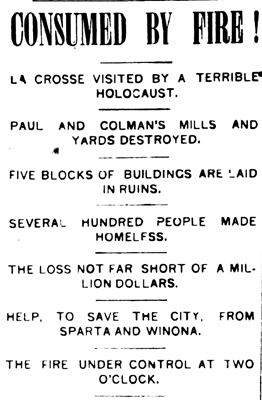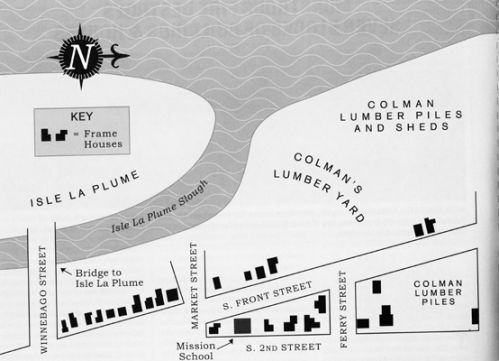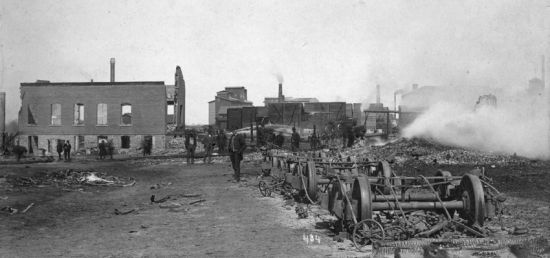
Fire!
(written by Barry McKnight, Archives staff)
For a town built by the lumber industry like La Crosse, the threat of fire held a particular terror. On the morning of April 6, 1886, a fire started in John Paul’s sawmill on the corner of Front and Cass Streets. Spreading quickly, it completely destroyed the sawmill and several hundred thousand feet of lumber. Aided by high winds, the fire swept south for five blocks to Winnebago Street. Along the way, it destroyed the Colman sawmill and lumber yards, the La Crosse Soap Company, several other lumber yards and a number of houses. Only great effort kept the huge stacks of lumber on Isle la Plume from igniting.

(Republican and Leader, 6 April 1886)
This wasn’t the first major fire to threaten the downtown area. The business district had been savaged by fire repeatedly in the 1850s and 1860s, destroying the original wooden buildings. Fire limits put in place in 1857 called for new buildings between Vine and Jay Streets and from Front to Second Street to be built of stone or brick. This area was expanded in the 1860s but the area containing the John Paul mill and others was outside of this restriction.
For the lumber mills, fire was a constant threat. Smoking was prohibited, watchmen were often posted, and the mills often possessed their own firefighting hoses and equipment. Often the mills were uninsured, either because premiums were too high or because the insurance companies refused to insure them.

map image from page 128 of True Tales of La Crosse, Douglas Connell (1994)
The fire that started that morning in April 1886 began in the planing room at the John Paul mill, likely with a spark igniting a pile of shavings or sawdust. No alarm was sent for several minutes, until it became clear that employees could not contain the blaze. Within a half hour, the fire had consumed the mill and had spread to the piles of lumber surrounding it. The heat was so intense that fire hoses melted and fire hydrants along the route of the fire exploded. Great whirlwinds of fire carried segments of roof high into the air before dropping them back to ground or in the river. Mayor Frank “Doc” Powell sent telegraph messages requesting help from other cities. Fire departments from Sparta and Winona answered the call, arriving by train along with their fire engines. The fire drew thousands of onlookers. In addition to the fire departments of the three cities, hundreds of men volunteered to help fight the fire, including many business and community leaders, such as Mayor Powell and Mons Anderson.

map image from page 129 of True Tales of La Crosse, Douglas Connell (1994)
The fire lasted five hours and left behind a five-block-long, one-block-wide scene of destruction littered with burnt machinery, smoking piles of lumber, and destroyed houses. Around 5 million feet of lumber were burned. The monetary damages were also extensive. In 2016 dollars, the fire cost over $10 million. Miraculously, no one was killed or seriously injured fighting the blaze.

Ruins of John Paul’s Mill April 6, 1886

Ruins of Milwaukee and St Paul rail cars in lumber yard
As a side note, the fire occurred on election day for the office of mayor. Doc Powell was up for re-election, which he won. In the aftermath of the fire, allegations flew between Powell and his opponents. Powell was ever-present fighting the fire and his supporters pressed flyers for his new “Workingman’s Party” into the hands of onlookers. His political opponents, it was alleged, did not help fight the fire but instead watched from a safe distance. In the aftermath of the fire, many mill workers were jobless. Powell took immediate steps to put them to work on civic projects until the mills were rebuilt.
For more information regarding this and other fires in La Crosse, visit the Archives department at the La Crosse Public Library.

